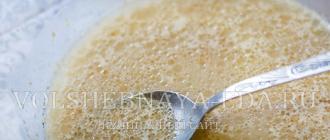Dielectric insert (insulating insert, dielectric insert for gas) -
This is a device that prevents the spread of so-called leakage currents (stray currents) through intra-apartment or intra-house gas pipelines. The dielectric insert not only eliminates possible heating and sparking of the liner in the event of accumulation of electrical potential, but also protects the electronics and internal electrical circuits of gas appliances and meters from failure due to the influence of harmful stray currents.
The main causes of leakage currents include the following:
- Damage to the general insulator at the entrance of the main pipe to apartment building or an insulator at the outlet of a gas distribution point (node). To protect against corrosion, a small electrical potential is specially applied to the main pipes. In the event of damage to the common insulator, this potential freely enters the intra-house and intra-apartment gas pipelines.
- Faulty or missing grounding electrical wiring in the house. Modern gas-consuming equipment has its own electrical circuits (electronic control units, electric ignition systems, lighting, etc.), and, in the absence electrical grounding, as well as in the event of a malfunction of the internal electrical circuits of gas-consuming equipment, these devices themselves become sources of stray currents.
- Unqualified connection electrical appliances and their illegal grounding your neighbors (or the “craftsmen” they hired) on rigid gas pipes and risers.
Dielectric insert It is a permanent connection and is installed between the gas tap and the gas supply. The metal parts of the insert, fused into the dielectric, do not touch each other, which makes it impossible for leakage currents to pass through it (the insert). Insulating insert has an internal surface completely covered with a dielectric, which eliminates contact of each of the metal parts of the insert with the gas passing inside the insulator.
Materials used:
- Metal parts: Sanitary brass LS59-1 according to GOST 15527;
- Electrical insulator: Polyamide according to GOST 14202-69 with fire resistance category PV-O according to GOST 28157-89.
Specifications:
- Nominal pressure PN 0.6 MPa, which is 200 times more normal pressure gas in household gas networks (according to SNIP 2.04.08-87 and  3.05.02-88, gas pressure up to 0.03 atm is considered normal);
3.05.02-88, gas pressure up to 0.03 atm is considered normal);
- Operating temperature: from -60 to +100 degrees Celsius, which makes it possible to install the insert in unheated rooms;
- Pipe thread, 1/2" or 3/4";
- Inner passage diameter: 10.0 mm (for 1/2") and 14.5 mm (for 3/4")
- Electrical resistance at a voltage of 1000V is more than 5 MOhm;
- The insert does not require maintenance during operation.
Employees gas services In some regions, it is already mandatory to use a dielectric insert in intra-apartment and intra-house gas pipelines. In particular, its use is regulated by the order of MOSGAZ dated December 26, 2008. No. 01-21/425: "When replacing gas stoves and connecting them to flexible liner provide a dielectric insert."
“The spool is small, but expensive” - this expression is perfectly suited for the dielectric insert. The cost of this product is negligible even compared to the cost of possible repairs of electronic and electrical components of modern gas equipment, not to mention the consequences of emergency situations such as fire or explosion.
Dielectric insert(or - permanent connection that prevents the spread of leakage currents. The dielectric insert also protects electronic components (for example, control units) and electrical circuits (for example, electric ignition system, lighting) of gas-consuming equipment from the harmful effects of stray currents. The insert is installed between the gas tap and the gas supply. Of course, the gas meter can also suffer from stray currents. And, importantly, the insulating insert eliminates possible heating and even sparking of the metal gas line as a result of the accumulation of electrical potential on it.
There are several reasons for the occurrence of stray currents, or leakage currents. The main ones are:
-Damage to the insulator on the gas main. On steel pipes In order to prevent corrosion, main gas pipelines are specially supplied with a small electric potential, which must be extinguished at the entrance to the apartment building or at the exit from the gas distribution unit in the immediate vicinity of the outlet to the individual house. For these purposes, a special main dielectric insert is used. In case of its destruction or absence, the electrical potential freely penetrates into the intra-house and intra-apartment gas pipelines.
-Lack of electrical grounding, faulty wiring and  local electrical circuits. Modern gas consuming appliances ( gas boilers and water heaters, stoves, ovens, etc.) are often crammed with electronics and local electrical circuits. These include electronic control modules, electric ignition, timers, lighting systems, etc. In the absence of the necessary electrical grounding, as well as when electricity enters the metal body of the equipment due to a malfunction of local electrical circuits (the so-called ground fault), such equipment itself becomes a source of harmful currents.
local electrical circuits. Modern gas consuming appliances ( gas boilers and water heaters, stoves, ovens, etc.) are often crammed with electronics and local electrical circuits. These include electronic control modules, electric ignition, timers, lighting systems, etc. In the absence of the necessary electrical grounding, as well as when electricity enters the metal body of the equipment due to a malfunction of local electrical circuits (the so-called ground fault), such equipment itself becomes a source of harmful currents.
-Illegal grounding of electrical appliances on gas steel pipes. Often your neighbors, who have entrusted the work of connecting certain electrical appliances to “craftsmen,” are blissfully unaware of the fact that their (neighboring) electrical appliances are grounded to a gas pipe.
TECHNICAL SPECIFICATIONS:
Connection dimensions insulating inserts: 1/2", 3/4";
Execution option: fitting-fitting;
Material of metal parts: brass CW614N according to EN12165, analogue of sanitary brass LS59-1 according to GOST 15527;
Dielectric: Polyamide according to GOST 14202-69 with fire resistance category PV-0 according to GOST 28157-89;
Nominal pressure PN=6 Bar (or about 6 atm). For reference: according to SNIP 2.04.08-87, in intra-house and intra-apartment gas pipelines, gas pressure up to 0.03 atm is considered normal;
A conversion table for pressure units is available on our website.
Electrical resistance: more than 5 MOhm at U=1000V;
Operating temperature range: from -60 to +100 degrees. Celsius.
The use of an insulating insert is regulated by MOSGAZ Letter No. 01-21/425 dated December 26, 2008: “...When connecting gas stoves to a flexible connection, provide a dielectric insert.”
Dielectric insert:
To ensure that the stray electric current generated in the gas pipeline does not damage the gas appliances installed in our houses and apartments, special dielectric inserts or couplings for gas are used, which are installed between the gas pipe. What is “stray current”, why does it occur, why is it dangerous and how to protect gas appliances from it?
Stray current appears in the ground when power lines malfunction; it can occur due to an accident on an electric railway or tram tracks, or when power lines are in an emergency.
Difference between resistivity ground and steel structures of gas mains is so great that the current goes not into the ground, but into these same metal structures. Due to the fact that both domestic and main pipelines are made of metal, stray current goes directly into our gas system.
Stray current suddenly appears when the boiler or column connected to electricity is installed incorrectly. It turns out that stray current is a real serious problem for the safety of not only one individual apartment, but also an entire multi-story building.
Insulating barrel and squeegee
Application of dielectric inserts for gas: what they are needed for and their functions
1. As a result of exposure to stray current, your gas appliances may lose their functionality or become sources of stray current themselves.
2. If a stray current occurs in the pipeline, then during a thunderstorm or emergency situation On a power line, a person can be seriously injured with the most severe consequences.
3. A spark may appear in the gas pipeline as a result of stray current, which creates a real threat of fire, and in the event of an explosion gas mixture Not only one apartment, but an entire multi-storey building can be blown up.
A dielectric insert is far from being someone’s whim; it is an obligation to install for those who have in their house or apartment gas equipment connected to electricity.
That is why, when laying a gas distribution pipe, the contractor must be guided by a set of rules (SP 42-101-2003, paragraph 6.4), which talks about the mandatory installation of dielectrics, even if the pipeline is not made of metal, but, say, polyethylene.
Types of dielectric inserts for gas
Dielectric inserts for gas are manufactured by our industry in several versions. They are usually divided into two main types:
1) insulating couplings, barrels, pipes, taps;
2) dielectric bushings.

Dielectric coupling for gas
Couplings are devices that have internal threads at the end. Couplings are installed between the gas appliance and the gas pipe.
Dielectric couplings are conventionally divided into 3 main types, differing from each other only in thread diameter:
— ⌀ 15 mm or 1/2′;
— ⌀ 20 mm or 3/4′;
— ⌀ 25 mm or 1′.
This division by thread size allows you to install couplings on any pipeline system with absolute accuracy, since thread diameters less than 1/2′ and more than 1 1/4′ are not used in our gas pipeline system. Dielectric couplings are not just desirable, but mandatory when installing hoses for gas appliances.

Tap with isolating coupling
Dielectric couplings can be classified not only by thread size, but also by the method of their connection:
1. Barrel (“nozzle-nozzle”): both ends have external threads.
2. Barrel (“nut-fitting”): one end has an internal thread, the other - an external thread.
3. Coupling (“nut-nut”): both sides with internal thread.
Unlike a coupling, a bushing is a liner that does not allow electrical current to pass through. Installed between the gas pipe and the supply line. The bushings differ from each other only in their size, that is, the diameter of the liner. It is customary to use bushings with a diameter of 8 to 27 mm.

Dielectric sleeve for gas
Despite all the differences, both couplings and bushings have such common indicators as:
- are made from non-flammable material, a polyamide with very high level resistance up to 5 million ohms;
— have approximately the same strength indicator: the working pressure of both couplings and bushings is 6 atmospheres, and the maximum withstand pressure is about 493 atmospheres.
How to properly install the dielectric insert
Both the coupling and the bushing are installed between the gas pipe and the hose. If you install the dielectric yourself, pay attention to the order and sequence of your manipulations.
1. Shut off the gas in the pipe through which it is supplied to the gas appliance.
2. In order for the gas in the supply to burn out to “zero”, you need to leave the burners on gas appliances open.
3. Prepare two adjustable wrenches.
4. Use the first wrench to hold the tap on the pipe, and with the second, unscrew the nut of the flexible hose (it is necessary to have two adjustable wrenches to prevent gas from gushing out).
5. Screw the hose nut, through which gas flows from the pipe to the gas appliance, to the end of the coupling.
6. Check your work for leaks by applying soapy water to the joint with a shaving brush.
Open the valve, make sure there are no bubbles at the joints, if there are none, then your job is done correctly.

Correct installation of the dielectric insert for gas
Dielectrics are presented on our market in a large assortment and in different price categories. Here you can buy a product that suits you in terms of quality for just a hundred rubles, or you can shell out several thousand for foreign-made products. So, as they say, there is a choice for every taste and budget.
Manufacturers and prices
To feel the difference in price, let’s compare just a few dielectrics of domestic and imported production. The trademark “Tuboflex” (a Turkish brand that was transferred to the Russian campaign) is now in good demand:
— bushing, connection for gas (thread-thread) “TuboFlex”, price 159 rubles;
— sleeve, nut-fitting connection, “TuboFlex” ⌀ 20 mm, price 146 rubles;
— coupling “Lavita” HP 20mm, thread ⌀ 3/4′, price 250 rubles;
— detachable coupling “Viega Sanpres 2267-22X1”, price 3075 rubles;
— detachable coupling “Viega G3 Sanpres 2267-20X1”, price 4033 rubles.
Today we looked at dielectric inserts (couplings, bushings), application, why they are needed, their characteristics and prices. We looked at the types of dielectrics and the differences between insulating threaded connections. Let's watch the video.
1.Scope of application
1.1. Insulating inserts (hereinafter referred to as inserts) for indoor gas pipelines are designed to prevent leakage currents from flowing through the gas pipeline when an electrical potential occurs on the body of a neutralized electrified gas appliance.
1.2. The inserts are designed for installation on gas pipelines transporting natural gas according to GOST 5542-87 and liquefied gas according to GOST 20448-90 and GOST R 52087-2003.
1.3. Application of the insulating insert provided for by SP 42-101-2003 ( General provisions on the design and construction of gas distribution systems made of metal and polyethylene pipes).
2.Specifications

2.1. Inserts are manufactured in accordance with TU 4859-008-96428154-2009.
2.2. The production of inserts is carried out in a mold on a thermoplastic machine using the method of screw extrusion using polymer material as an electrical insulator and metal threaded pipes.
2.3. Operating pressure of the insert: 0.6 MPa.
2.4. Breaking insertion pressure. 1.2 MPa, no less.
2.5. Operating temperature: from -20"C to +80"C.
2.7. Electrical strength. The inserts can withstand 37508 AC test voltage at 50Hz applied to the metal fittings. Electrical breakdown is not allowed. Electrical strength is ensured for 1 minute, no less. The leakage current does not exceed 5.0 mA.
2.8. The specific electrical resistance of the DC insert with voltage 10008 is 5.0 MOhm, no less.
2.9. Resistance category of polymer electrical insulating material is PV-0 (according to GOST 28157-89). Electrical insulating material has a distinctive color yellow(according to GOST 14202-69, group 4, flammable gases (including liquefied gases)) At the request of the consumer, the use of black material is allowed.
2.10. Marking. Markings are applied to the surface of the electrical insulating material, including the brand name, 1/DI-GAS, and nominal diameter, for example, DN20.
2.11. Nominal diameters of inserts (threaded pipes): DN15 (1/2"), DN20 (3/4").
2.12. Inner diameter of the passage. DN15 10.0 mm, DN20: 15.0 mm.
2.13. Connection type: cylindrical pipe thread, external/external thread.
3. Transportation and storage

3.1. Inserts can be transported various types transport, subject to protection from mechanical damage and exposure to precipitation in accordance with the rules of transportation for this type of transport.
3.2. Inserts are stored in closed and other premises with natural ventilation without artificially controlled climatic conditions, where fluctuations in air temperature and humidity are significantly less than at outdoors(for example, stone, concrete, metal storage facilities with thermal insulation and other storage facilities) located in any macroscopic areas, including temperate and cold climates.
4. Installation and operating instructions

4.1. Installation of the Insert must be carried out by specialists who have been trained and have a license to connect gas equipment.
4.2. It is prohibited to dismantle/install the Insert without first closing the gas supply valve.
4.3. The inserts do not require verification or maintenance during operation.
4.4 The insert is used in conjunction with a flexible metal eyeliner to gas electrified appliances and is installed on the intra-apartment gas pipeline on the outlet after the tap.
5. Manufacturer's warranty
5.1. The manufacturer guarantees that the inserts comply with the requirements of TU 4859-008-96428154-2009 provided that the consumer complies with the conditions of transportation, storage, installation and operation.
5.2. Warranty period operation - 36 months from the date of commissioning of the Insertion, but not more than 60 months from the date of manufacture, subject to compliance with the rules of storage, installation and operation.
5.3. The service life of the insert is 20 years. Does not require maintenance during operation.
5.4. The manufacturer reserves the right to make changes to the design of the Insert without notifying the consumer.
>Why do you need a dielectric coupling for gas and how to install it?
Dielectric coupling is a cut-off fitting that protects the “brains” of gas-consuming devices from the destructive effects of stray currents. That is, we have before us a very useful unit, the effectiveness of which has been proven by the definition itself. However, many owners of gas stoves, water heaters and boilers, as well as employees of gas services, do not know about the existence of such an insert. And in this material we will try to eliminate this gap in knowledge by talking about the benefits dielectric fitting, its varieties and installation methods.
Stray current - where does it come from in the gas pipeline
Such currents appear in the ground due to an accidental breakdown of a household or industrial power line. The source of stray voltage can be either a grounding loop or an electrified railway or tram line. This current enters the gas pipeline due to the difference between the resistivity of the earth and the metal parts of the gas supply line. In fact, all electricity discharged into the ground does not go into the ground (it has too much resistance), but into uninsulated cables or metal structures. And since most of the main and household gas pipelines are made of metal, the appearance of stray current in the system is only a matter of time.
The main pipe can become a source of stray voltage in a household gas pipeline. To protect the gas supply pipeline from corrosion, the line is loaded with an electrical potential of insignificant strength, which suppresses the natural process of electrochemical splitting in the structural material. And if a breakdown of the dielectric insert for gas occurs in the common insulator separating the main line from the household branch, then the useful protective potential will turn into an unwanted stray current.
In addition, stray voltage may appear in the internal gas supply line due to poor grounding of the circulation pump or other electrical appliances in contact with the heating system wiring or the home gas pipeline branch. Another reason for the appearance of such currents may be an error when installing a boiler, column or gas stove connected to the electrical network. As you can see, stray current is not a myth, but a real problem. And the metal structure that falls under its influence turns into a serious threat to the safety of all residents of the house connected to the gas pipeline.
What happens if the system does not have a shut-off fitting?
To cut off stray currents in pipelines, use a special dielectric insert. It cuts into the area between the tap and the supply to the gas-consuming device. Or in the area between the gearbox and gas meter. What happens if there is no such insert? Believe me, nothing good.
- Firstly, your or your neighbor’s stove, water heater or boiler may suffer from stray current or become a source of it. As a result, there is a risk of losing their functionality due to damage to the “smart” filling, assembled on the basis of capricious chips that react even to minor voltage surges.
- Secondly, a spark may occur in the pipeline - a source of fire. Moreover, cases of spontaneous combustion of the liner are not so rare. And if this fact is not discovered in time, the matter could end in a big disaster. The detonation of the gas-air mixture can destroy even an apartment building.
- Third, the user may be hit electric shock. If the potential of a stray charge is significant, and this happens during a thunderstorm or a power failure, then we may not be talking about an unpleasant “bite”, but about a full-fledged injury with difficult to predict consequences.
Types of dielectric cut-offs - couplings and bushings
The product range of stray current cut-off devices for gas distribution systems is usually divided into two groups, which include:
Dielectric couplings (MD)- special fittings with threaded ends, mounted between the gas pipeline and the device consuming blue fuel.
Dielectric bushings (VD)- non-conducting liners installed in the place of dismountable coupling of gas pipeline elements.
In turn, the range of couplings is divided into four standard sizes, based on the diameters of the threaded part: ½, ¾, 1, 1 ¼. Such a set allows you to cover all varieties pipeline fittings, used in gas pipelines, since diameters less than ½ inch and more than an inch and a quarter are not used in such systems. In addition, the range of couplings can be divided according to the design features of this fitting into three groups: MD thread/thread, MD thread/nut, MD nut/nut. After all, the thread of this fitting can be cut both outside and inside the end part.
The range of dielectric bushings is divided only on the basis of their geometric dimensions - by the diameter of the liner. In this case, we are dealing with 11 standard sizes and diameters from 8 to 27 millimeters. At the same time, both couplings and bushings have the same safety margin. The working pressure of both types of cut-off valves is 0.6 MPa (about 6 atmospheres), and the maximum pressure is 50 MPa (493 atmospheres). In both cases, a practically non-flammable polymer is used as a dielectric - polyamide, which has a colossal resistance (about 5 million Ohms).
How to install the coupling - act carefully
Dielectric coupling must be mounted between the gas distribution valve and the consuming appliance, therefore, when installing dielectric cut-offs, the following sequence of actions is used:
- Close the valve to metal pipe, supplying gas to the stove, boiler or column. In this case, it is better to leave the burners of the devices open so that the gas in the supply burns out.
- Holding the valve body with the first adjustable wrench, carefully twist the inlet nut with the second wrench - a flexible pipeline (hose) connecting the shut-off unit to the gas inlet pipe of the boiler, stove or column. The use of a pair of keys in this case is mandatory, since the supply nut can “stick” to the fitting or branch pipe of the valve and transmit torque to it, after which gas will flow into the room, and its supply can only be shut off with a street reducer valve.
- We screw the FUM coupling (polymer seal) onto the free ends of the coupling and screw it into the gas pipeline valve by hand. Next, take the same two keys and, holding the valve body, screw in the coupling until it stops. Be careful not to overdo it at this stage, as too much force will cause the valve body to deform and cause gas to leak.
- We screw the supply nut to the device consuming gas onto the free end of the coupling, controlling our force and holding the fitting with one of the adjustable wrenches.
- Next, you need to check the tightness of the resulting connection. To do this, you need to purchase a shaving brush and, after thoroughly lathering it, treat all the joints of the valve, coupling and supply. After this, you open the valve and observe the foam at the joints. If you do not see any bubbles, the joints are sealed tightly and your gas pipeline is ready for safe operation.
If found soap bubbles At the joints you need to close the gas supply valve and carefully tighten the coupling or supply nut. If this does not help, you will have to disassemble the entire connection and add several turns of FUM to the ends of the coupling.
Attention: the use of matches or lighters instead of soap foam when testing the tightness of joints is strictly prohibited. You may not have time to react and turn off the gas, causing a serious fire.
And if there is a strong leak, you may be overwhelmed by panic - the sight of a flaming valve unbalanced even the most cold-blooded craftsmen. Therefore, the best leak tester is soap suds.






